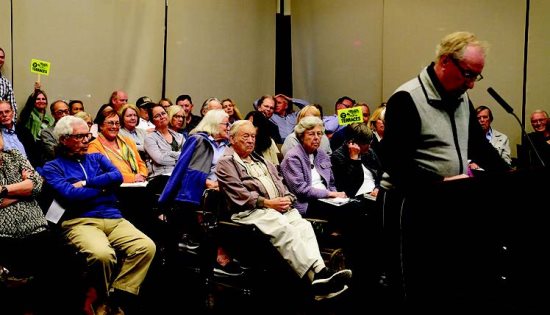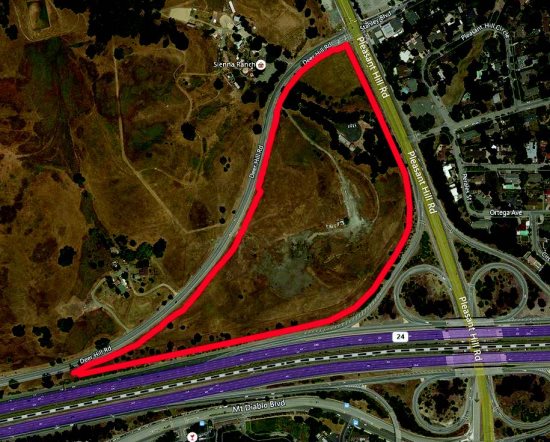
The Don Tatzin Community Hall was packed for a special meeting of the Lafayette City Council and the Planning Commission April 29 as city staff gave an update on the Terraces, a 315-unit apartment project on Deer Hill Road, specifically discussing how to proceed with the environmental review.
After close to 20 members of the public weighed in on the controversial issue, the Planning Commission unanimously agreed to refer the project to the Transportation and Circulation Committee, and the council minus Vice Mayor Susan Candell who, following legal advice recused herself from all discussion around the Terraces, unanimously voted to hire consultant Impact Sciences to do further analysis and prepare an addendum to the environmental impact report.
The Terraces project, which would sit on a 22-acre parcel on Deer Hill Road, was first proposed in March 2011 but its application was suspended in 2014 in favor of alternative plans for a scaled back development of 44 single-family homes, a dog park, a playing field, a playground and tot lot. Local preservationist group Save Lafayette sued the city, resulting in a referendum last June on the future of the revised project. With the defeat of Measure L, the developer O'Brien Homes resumed the original application for the apartments.
The application was deemed complete in 2011 and the city retained Placeworks at the time to prepare an EIR, which was certified in August 2013. Since five years have passed, further review under the California Environmental Quality Act is required. But should that be in the form of an addendum or a supplemental EIR?
The audience heard from attorney Robert Hodil of Coblenz, Patch, Duffy and Bass - the outside counsel hired by the city - that, in his opinion and that of Impact Sciences, an addendum rather than an SEIR is called for to examine the identified areas of transportation, air quality and noise, as well as (potentially) greenhouse gas impacts.
Members of the public present, and the many letters sent to council on the subject, overwhelmingly demanded the council call for an SEIR and the guaranteed full public hearings that it would entail rather than the addendum for which public hearings are not required. Residents spoke of traffic implications, potentially worsened by such a large development, and several spoke of the potential for delayed response times for emergency vehicles unable to get through traffic.
Mayor Mike Anderson repeatedly had to ask for people not to applaud to avoid the possibility of intimidating those who might hold another opinion and, in fact, only one got up to speak in favor of the apartments.
Save Lafayette co-founder Michael Griffiths points out that under CEQA guidelines, unlike supplemental and subsequent EIRs, an addendum need not be circulated for public review.
"The notes under guideline 15164 say it (an addendum) is only for minor corrections in EIRs," says Griffiths. "The developer's draft proposed addendum with appendices runs to 1,000 pages - have you ever met a thousand-page `minor correction'? Worse, it seeks to undo (without explanation) all of the significant and unavoidable public health and safety impacts recited in the certified final EIR approved in 2013. Seven years have passed since the data in the original EIR was collected, and there have since been substantial changes in the traffic and public safety considerations; this mandates a more rigorous subsequent document."
Several times all four city council members asked about the process and whether they could continue having public hearings with an addendum. Acting Planning Director Greg Wolff reassured them that it would be possible. Hodil agreed but noted that it is not typically done in the city of Lafayette although it is allowable under CEQA.
Council Member Steven Bliss asked if analysis from the consultant around the addendum could still trigger an SEIR and was told it could.
Mayor Mike Anderson said after the meeting that nothing has really changed here. "Nothing is off the table," he said, referring to the addendum versus the SEIR.
With the decision to move forward with the addendum, the city is hiring traffic consultants TJKM who worked on the original Terraces EIR. Wolff said the hire made sense because of their "long-term familiarity and knowledge on it."
It is precisely the long-term familiarity that makes Lafayette resident Scott Sommer uneasy.
"Although TJKM worked for the city in 2012, it is now working for and under contract with O'Brien Land. This taints any choice of TJKM to objectively and independently work for the city," says Sommer, adding, "Also, the idea of TJKM reviewing its own traffic memorandum is meaningless and illusory. Independent and impartial review is a key concept of CEQA and administrative law. An independent traffic consultant should be retained by the city to independently review TJKM's submission."
Wolff says that TJKM is well respected and will be taking direction from the city. Addressing any concerns about the potential for the developer to hire a consultant to become their mouthpiece, Wolff says, "That is why the city is retaining Impact Science."
The saga continues.
After close to 20 members of the public weighed in on the controversial issue, the Planning Commission unanimously agreed to refer the project to the Transportation and Circulation Committee, and the council minus Vice Mayor Susan Candell who, following legal advice recused herself from all discussion around the Terraces, unanimously voted to hire consultant Impact Sciences to do further analysis and prepare an addendum to the environmental impact report.
The Terraces project, which would sit on a 22-acre parcel on Deer Hill Road, was first proposed in March 2011 but its application was suspended in 2014 in favor of alternative plans for a scaled back development of 44 single-family homes, a dog park, a playing field, a playground and tot lot. Local preservationist group Save Lafayette sued the city, resulting in a referendum last June on the future of the revised project. With the defeat of Measure L, the developer O'Brien Homes resumed the original application for the apartments.
The application was deemed complete in 2011 and the city retained Placeworks at the time to prepare an EIR, which was certified in August 2013. Since five years have passed, further review under the California Environmental Quality Act is required. But should that be in the form of an addendum or a supplemental EIR?
The audience heard from attorney Robert Hodil of Coblenz, Patch, Duffy and Bass - the outside counsel hired by the city - that, in his opinion and that of Impact Sciences, an addendum rather than an SEIR is called for to examine the identified areas of transportation, air quality and noise, as well as (potentially) greenhouse gas impacts.
Members of the public present, and the many letters sent to council on the subject, overwhelmingly demanded the council call for an SEIR and the guaranteed full public hearings that it would entail rather than the addendum for which public hearings are not required. Residents spoke of traffic implications, potentially worsened by such a large development, and several spoke of the potential for delayed response times for emergency vehicles unable to get through traffic.
Mayor Mike Anderson repeatedly had to ask for people not to applaud to avoid the possibility of intimidating those who might hold another opinion and, in fact, only one got up to speak in favor of the apartments.
Save Lafayette co-founder Michael Griffiths points out that under CEQA guidelines, unlike supplemental and subsequent EIRs, an addendum need not be circulated for public review.
"The notes under guideline 15164 say it (an addendum) is only for minor corrections in EIRs," says Griffiths. "The developer's draft proposed addendum with appendices runs to 1,000 pages - have you ever met a thousand-page `minor correction'? Worse, it seeks to undo (without explanation) all of the significant and unavoidable public health and safety impacts recited in the certified final EIR approved in 2013. Seven years have passed since the data in the original EIR was collected, and there have since been substantial changes in the traffic and public safety considerations; this mandates a more rigorous subsequent document."
Several times all four city council members asked about the process and whether they could continue having public hearings with an addendum. Acting Planning Director Greg Wolff reassured them that it would be possible. Hodil agreed but noted that it is not typically done in the city of Lafayette although it is allowable under CEQA.
Council Member Steven Bliss asked if analysis from the consultant around the addendum could still trigger an SEIR and was told it could.
Mayor Mike Anderson said after the meeting that nothing has really changed here. "Nothing is off the table," he said, referring to the addendum versus the SEIR.
With the decision to move forward with the addendum, the city is hiring traffic consultants TJKM who worked on the original Terraces EIR. Wolff said the hire made sense because of their "long-term familiarity and knowledge on it."
It is precisely the long-term familiarity that makes Lafayette resident Scott Sommer uneasy.
"Although TJKM worked for the city in 2012, it is now working for and under contract with O'Brien Land. This taints any choice of TJKM to objectively and independently work for the city," says Sommer, adding, "Also, the idea of TJKM reviewing its own traffic memorandum is meaningless and illusory. Independent and impartial review is a key concept of CEQA and administrative law. An independent traffic consultant should be retained by the city to independently review TJKM's submission."
Wolff says that TJKM is well respected and will be taking direction from the city. Addressing any concerns about the potential for the developer to hire a consultant to become their mouthpiece, Wolff says, "That is why the city is retaining Impact Science."
The saga continues.

Reach the reporter at: